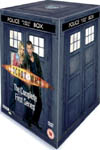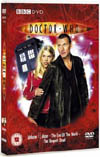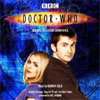DVD Extras (box sets only) include:
Pilot PerspectiveOne critical element was very correct - the first story of a new season, with a brand new Doctor, was treated as a pilot episode, and a brand new audience was given everything it needed to get into the series and enjoy it. Very well done.Audience identification figure Rose Tyler is very much the main protagonist of this first story, and it is through her eyes and investigation that we slowly discover the Doctor and the bizarre vehicle that he uses to take himself, his companions, and us viewers on adventures through time and space. However, as companions go, (and many have come and gone during the first 26 years of this show), Rose is not a very interesting character in and of herself. She simply appears to be a modern working-class manifestation of the cliché dumb blonde, with poor taste in clothes. And her mother is on hand to demonstrate that it's something of a family tradition. Whether all this helped to connect the show with the ideal new viewers that the production team wanted to acquire is another matter; a year's hindsight says they didn't do too badly in this area.
In SequenceThe music and graphics of the title sequence fire off all the right anchors for those familiar with the show. Thankfully and wisely, the production team decided to continue the tradition of showing episode titles on screen (anything else is completely ridiculous for a collectible well-loved show with a popular cult following).The opening montage leaves something to be desired in establishing that Rose actually works at the department store. The closest it comes to demonstrating that is showing her fold one sweater and place it on top of a pile. My impression was that she was shopping, and putting back something she had decided to not buy. It would have helped if she'd been wearing a company uniform or something befitting a professional salesperson, or if the montage had spent more screen time showing her working than eating lunch with her boyfriend. It all seemed like more of a materialistic day of fun-on-the-town than another hum-drum day of work. It isn't until the dialogue begins during the basement sequence that Rose's relationship with the store begins to become clear.
Eccleston AestheticsChristopher Eccleston's Doctor suddenly appears out of nowhere in the midst of action and mayhem, and remains a mysterious character in a dreadful hurry through the first half of the story, while Rose chases after him to get some answers. It's not unlike Alice chasing after the White Rabbit in "Alice in Wonderland".The dialogue is snappy and modern, somewhat refreshing in allowing Rose to call the Doctor on issues that fans have long wondered about, but which the show always used to shy away from. No more. But I'm not convinced that it made either of the two lead characters more appealing. On the plus side, both Christopher Eccleston and Billie Piper put in top notch acting performances... at least when they're not fighting a prop and trying to make it look alive. Eccleston seemed to possess the potential to go on to become a great Doctor, if only he got a few really great stories to sink his teeth into. But on the down side, Eccleston is the first Doctor that truly does not look the part, and we have mostly his costume to blame. The character has always boldly and proudly sported an anachronism, without caring too much whether or not he fitted in with the rest of whatever society he was visiting. As Lowrie Turner, fashion editor for the Evening Standard, pointed out in the documentary "More Than 30 Years in the TARDIS", however outlandish the costume may seem, it can be seen as a variation of an Edwardian gentleman's outfit. Eccleston never manages to look like an anachronistic gentleman; instead he looks like just another skinhead from modern times, and thus seems less authoritative in the role than any of his predecessors. His hair-cut is also much shorter than his predecessors, but I applaud this move. All Doctors from Peter Davison onwards always looked better the shorter their hair was. Then there's his time/space vehicle, the TARDIS. The police box looks great, and the re-use of the traditional sound effects for materialization and dematerialization was absolutely correct. But unfortunately the production crew decided to redesign the interior as a cross between an H.G. Wells time machine and a Dalek flying saucer. No better theory on the technique used to construct a TARDIS has been put forth than that by Christopher H. Bidmead in his back-to-back classic stories "Logopolis" (story no. 116) and "Castrovalva" (story no. 117). In story terms, most of the "solid" TARDIS walls are in fact meant to be computer generated - the exterior via the chameleon circuit, the interior via the architectural reconfiguration system. The main console housing these computer components may be the only real object used in its construction. So if the walls want to remain gleaming bright white as they definitively did during most of the show's earlier 26 year run, there isn't any reason why we shouldn't believe it. The tiny roundels on the walls are also inferior to their larger, more traditional counterparts. By setting them inside hexagons, and giving the walls a darker, rusty look, they really look like they were designed by some of the Doctor's worst enemies, the Daleks, instead of being part of the technology of his own people. Also, what happened to the "airlock"? Throughout the late 70's and early 80's, the white interior doors led to a black space, presumably the inside of the police box, which had yet another set of doors. "Four to Doomsday" (story no. 118) was particularly good at demonstrating how the two different sets of doors could be used one after the other as an airlock, when the atmosphere outside the vehicle isn't good to breathe. What will Eccleston's Doctor do when he lands on a truly alien planet? I sense a designer eager to flex his muscles and show what he or she can do. Best if that were saved for unknown things like new civilizations and alien planets. The TARDIS interior already had a greater design. It is pleasantly refreshing to learn that, as the story opens, this ninth incarnation of the Doctor has been around for some time. Russell T. Davies neatly side-stepped many of the problems faced by other Doctors during their first story by keeping distance from the regeneration event that would have seen the transition from Paul McGann's eighth Doctor to Eccleston's ninth, and the mental / personality / identity crisis that usually immediately follows such events. Such things never help new audiences to like or understand the show. The section with Clive the internet information junkie is perhaps logical, but of questionable value for the audience. He dumps a lot of misinformation on them, which ultimately goes unchallenged. It's also curious that he has nothing to show and tell about the previous eight Doctors, who have all left their fair share of trails on Earth before as well. This story is perhaps too short to go for an entire act without the Doctor's live presence, while Clive is allowed to spin so many tall tales in his absence.
Autons on AutomaticFinally we come to the antagonists of the story, the Autons. Davies plays it safe by bringing back a past Doctor Who success and using them in pretty much the formulaic pattern that Robert Holmes laid out for them back in "Spearhead From Space" (story no. 51) and "Terror of the Autons" (story no. 55). A few new tricks with plastic are thrown in for good measure, but these innovations are not particularly inventive or exciting. 2005 brings new capabilities for special effects - as usual Doctor Who tries to push the envelope for television, and not everything is totally believable.Logically, the sonic screwdriver has come back, and is rather unfortunately becoming the magic solution to all technical problems, including the Autons, reminding one of why previous writers got rid of it. Apart from its vital function in keeping the Doctor and friends out of the boring old capture and escape routines, the writers should define the limitations of the device and prevent its over-use. It is normally such a benign device, operating on sound, that it doesn't really need a visual beam added in post-production, but gets one anyway. Oh well. It looks nice. No Auton story is complete without a manifestation of the Nestene consciousness, and it is finally done more justice here than it ever has before. Very nicely done. Homage is also paid to the earliest Auton story by recreating some of the action we were all fooled into thinking we had actually seen then. Sadly there has not been time for any scenes of the Doctor actually investigating some of the more interesting typical Auton activities. Neither is there a strong humanoid villain for Eccleston to play off of either. Or better yet, perhaps some new ideas and dynamics might have been used. This might well double the length of the story, making it normal in comparison to all that has gone before. Ah well... The cast remains quite small for this short story, so we do at least get ample time to get to know everyone. Rose's boyfriend Mickey, played by Noel Clarke, gives an enjoyable and memorable performance. Camille Coduri is utterly convincing as Rose's mother, injecting a lot of charm and humour into the role. She and Piper were really well matched for a mother/daughter duo.
This story has become available on DVD:
Note: The 13-episode box sets contain commentaries, behind-the-scenes featurettes, and other extras. The 3-episode volumes only feature the plain episodes. Comments on this article are welcome. You may contact the author from this page:
|









